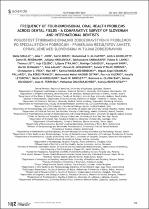| dc.contributor.author | Chantaracherd, Pathamas | |
| dc.contributor.author | Sekulić, Stella | |
| dc.contributor.author | John, Mike T | |
| dc.date.accessioned | 2022-08-05T09:25:47Z | |
| dc.date.available | 2022-08-05T09:25:47Z | |
| dc.date.issued | 2021 | |
| dc.identifier.citation | Sekulić, S. et al. (2021). Frequency of four-dimensional oral health problems across dental fields - A comparative survey of slovenian and international dentists. [Pogostost štiridimenzionalnih zobozdravstvenih problemov po specialističnih področjih - Primerjava rezultatov ankete, opravljene med Slovenskimi in tujimi zobozdravniki] Zdravstveno Varstvo, 60(4), 210-220. doi:10.2478/sjph-2021-0029 | en_US |
| dc.identifier.uri | doi:10.2478/sjph-2021-0029 | |
| dc.identifier.uri | http://hdl.handle.net/10566/7706 | |
| dc.description.abstract | Objectives: To compare the frequency of patients' oral health problems and prevention needs among Slovenian and international dentists with the aim to validate the four oral health-related quality of life (OHRQoL) dimensions across six clinical dental fields in all World Health Organization (WHO) regions. Methods: An anonymous electronic survey in the English language was designed using Qualtrics software. A probability sampling for Slovenia and a convenience sampling strategy for dentist recruitment was applied for 31 countries. Dentists engaged in six dental fields were asked to categorize their patients' oral health problems and prevention needs into the four OHRQoL dimensions (Oral Function, Orofacial Pain, Orofacial Appearance, and Psychosocial Impact). Proportions of patients' problems and prevention needs were calculated together with the significance of Slovenian and international dentists' differences based on dental fields and WHO regions. Results: Dentists (n=1,580) from 32 countries completed the survey. There were 223 Slovenian dentists (females: 68%) with a mean age (SD) of 41 (10.6) years and 1,358 international dentists (females: 51%) with a mean age (SD) of 38 (10.4). Pain-related problems and prevention needs were the most prevalent among all six dental fields reported by dentists; Slovenian (37%) and 31 countries (45%). According to Cohen, differences between Slovenia, the broader European Region, and 31 countries were considered non-significant (<0.1). Conclusion: According to the dentists' responses, the frequency of patients' oral health problems and prevention needs are proportionate between Slovenia and 31 countries, regionally and globally. The four OHRQoL dimensions can be considered universal across all dental fields. | en_US |
| dc.language.iso | en | en_US |
| dc.subject | Dental specialties | en_US |
| dc.subject | Dentistry | en_US |
| dc.subject | Oral health | en_US |
| dc.subject | Patients | en_US |
| dc.subject | Questionnaires | en_US |
| dc.subject | World Health Organization | en_US |
| dc.title | Frequency of four-dimensional oral health problems across dental fields - A comparative survey of Slovenian and international dentists | en_US |
| dc.type | Article | en_US |

